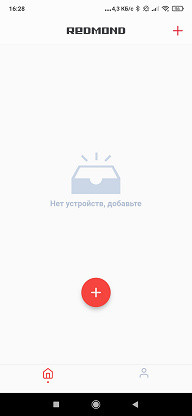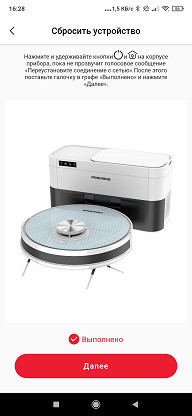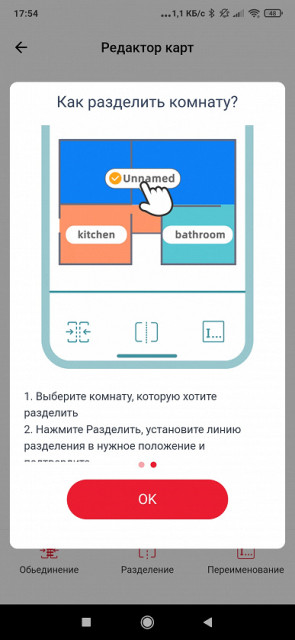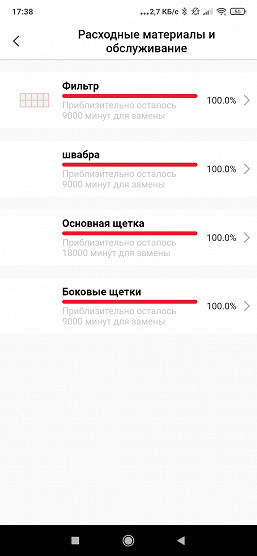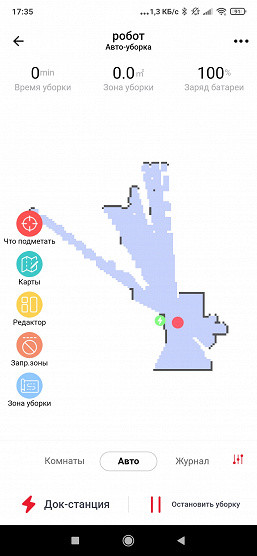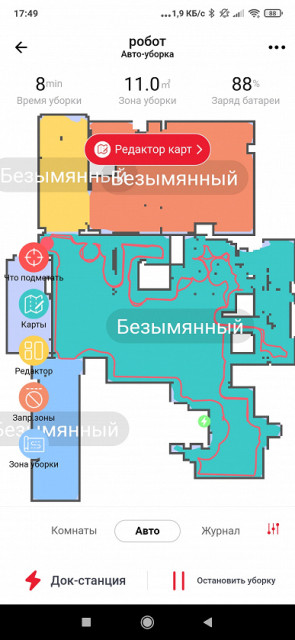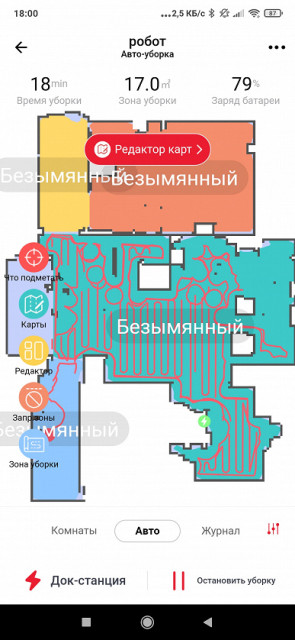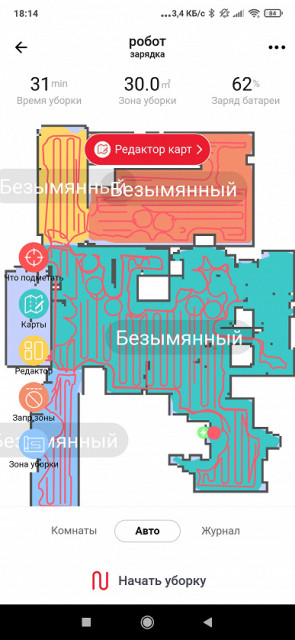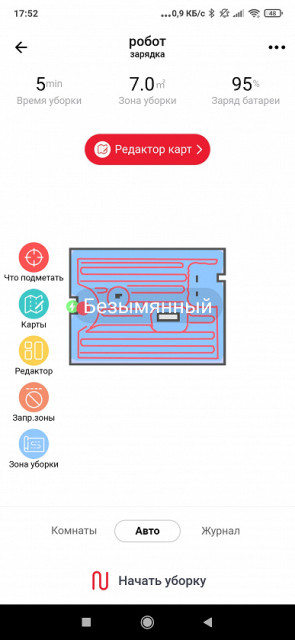The Redmond VR1322S robot vacuum cleaner is equipped with a lidar for navigation, two side brushes and a combined container for dry and wet cleaning. Its base also functions as a dust collector. This model offers several non-standard solutions.
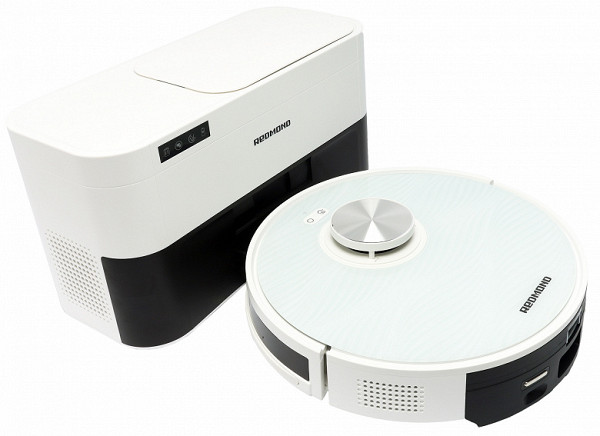
Characteristics
| Manufacturer | Redmond |
|---|---|
| Model | VR1322S WIFI |
| Type | robot vacuum cleaner with waste collection station |
| Country of origin | China |
| Guarantee | 1 year |
| Service life * | 3 years |
| Type of cleaning | dry, dry/wet |
| Sensor type | infrared optical, LDS (lidar) |
| Power | 50 W |
| Suction power | up to 2700 Pa |
| Suction power of the station | 27 kPa |
| Battery | Li-Ion, 14.4 V, 2600 mAh |
| Opening hours | up to 120 minutes |
| Charging time | 5 h |
| Dust collector capacity | 0.18 l |
| Volume of container for wet cleaning | 0.23 l |
| Remote control | infrared |
| Control from smartphone | Wi-Fi (iOS, Android, Redmond Home app) |
| Weight | 7.1 kg |
| Robot weight | 3.5 kg |
| Dimensions of the robot | 320×95×325 mm |
| Dimensions of the station | 392×215×188 mm |
| Length of network cable | 1.5 m |
* Contrary to popular belief, this is not a period after which the device will necessarily break down. However, after this period, the manufacturer ceases to bear any responsibility for its functionality and has the right to refuse to repair it, even for a fee.
Equipment
The cardboard box in which the robot vacuum cleaner is delivered has standard dimensions and design. The front side shows a high-quality photo of the device and a smartphone with a cleaning map, and the side edges contain information about key characteristics and features.
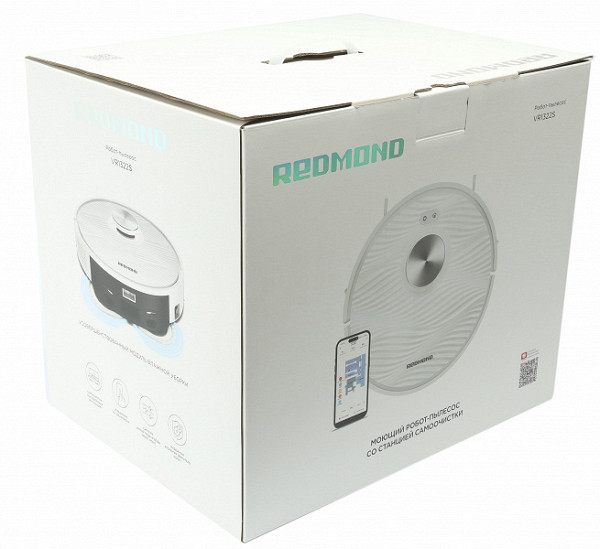
The packaging indicates that the vacuum cleaner supports the wet cleaning function and is controlled via a proprietary mobile application. The box is equipped with a plastic handle for easy carrying, and the contents inside are protected from impacts by pressed cardboard.
After opening the box, we found:
- A robot vacuum cleaner with an installed combined module for dry and wet cleaning and a floor cleaning cloth
- A base station with a DC adapter
- Two sets of side brushes
- Remote control
- Spare wet cleaning cloths
- An additional set of filters
- A knife brush for cleaning the robot
- User manual
- Service book
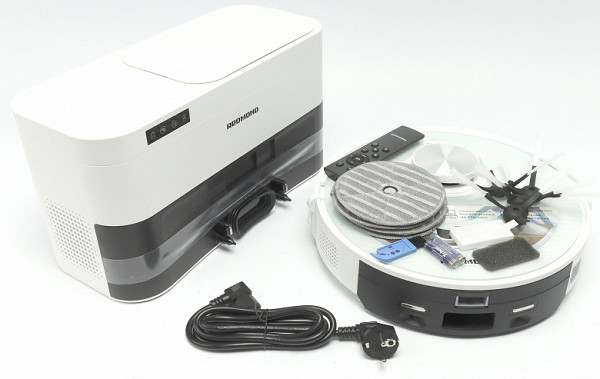
At first glance
Redmond VR1322S is a standard solution in the form of a «robot with a garbage collection base» with an added wet cleaning function, which includes self-addition of water and brush maintenance. The device looks stylish and elegant, and the base is compact without sacrificing functionality. Let's take a closer look at it.
Like most robots from Redmond, this device has a modern design. The top cover is made of transparent plastic with a light blue texture reminiscent of sand stains.
On the top panel there are two buttons for starting cleaning or sending the robot to the base for charging. Next to the buttons is an indicator of connection to the Wi-Fi network. In the center of the panel rises a lidar turret, under which is the Redmond logo.
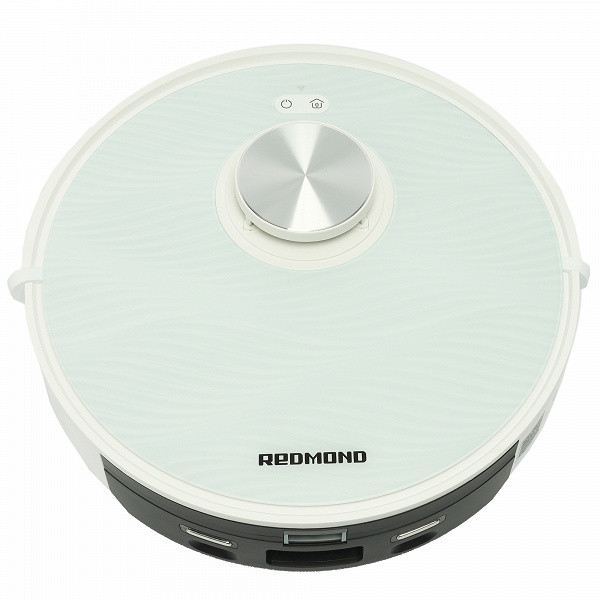
At first glance, the device is fairly standard in design, with the exception of a few features that we will discuss later.
The front of the case is equipped with a movable bumper, which also serves as a collision sensor. Its front surface is made of IR-transparent material, behind which are located IR sensors (there are 19 of them, according to the developer). Under the darkened plastic is a strip of porous material designed to protect the case and interior items from damage during collisions.
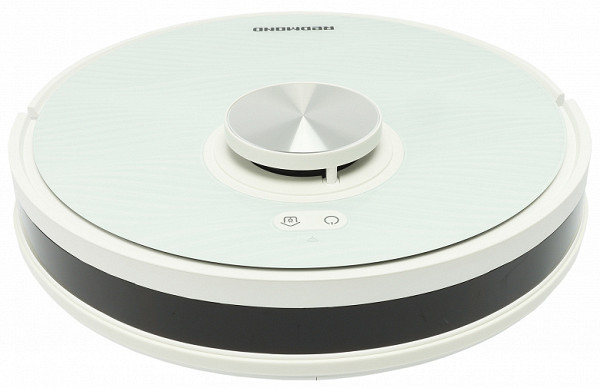
On the sides we see two grilles. On the right behind it is a speaker, and next to it is the robot's power button. The grille on the left is used to release air.
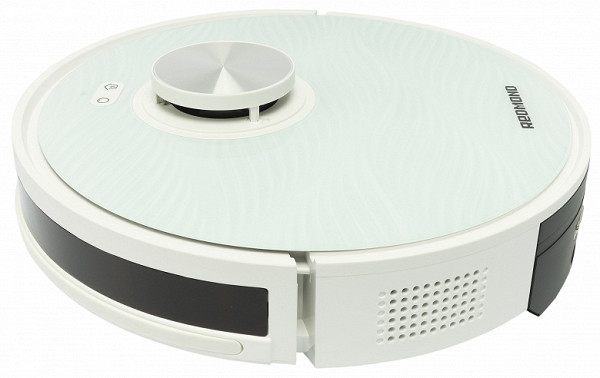
The lidar is housed in a traditional turret that rises slightly above the robot's body.
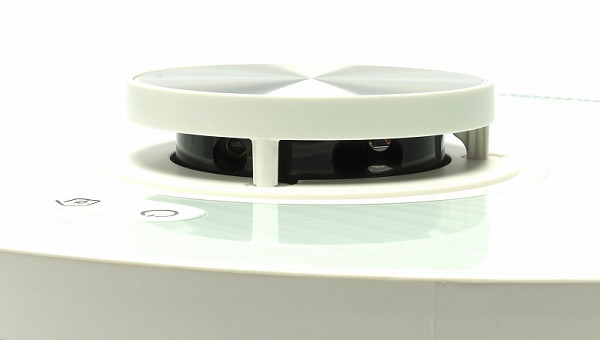
When in contact with low obstacles, the turret moves, thereby signaling the robot about the presence of an obstacle.

The robot vacuum cleaner is charged exclusively on the base and does not have a socket for connecting a power adapter. Charging is carried out through two contacts located on the dust container.
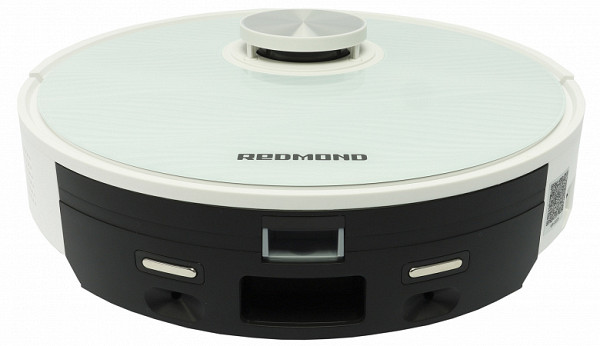
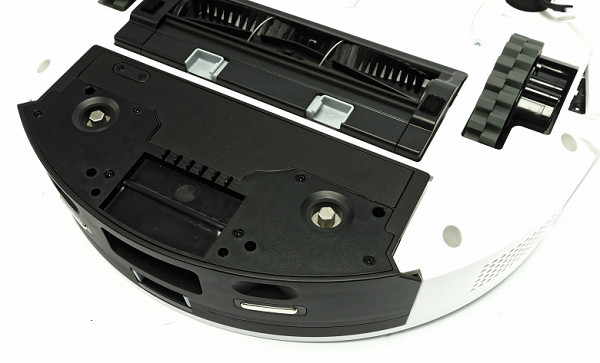
Otherwise, the removable container has a standard design.
On the top there is a plastic hinged lid that covers the opening for filling with water, and on the bottom there are four points for supplying water.

The round rotating attachments are attached with magnets. The fairly thick napkins are fixed with Velcro.
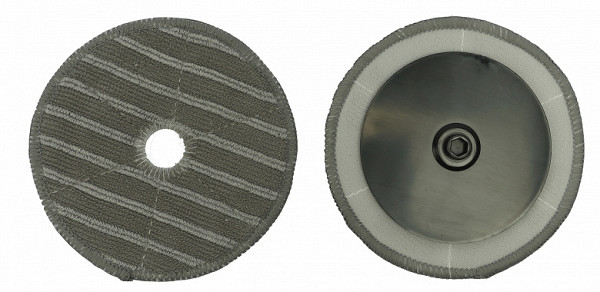
The collected dust enters the container, after which the air passes through a filter system and exits. The container can be cleaned manually, for which a special hatch is provided on the top.
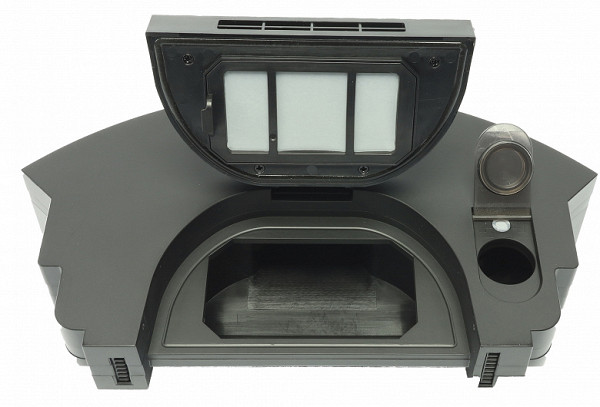
Three filters are used for filtration: a plastic frame with a synthetic mesh filter, then a foam filter and, finally, a HEPA filter for the smallest particles.

Turning the robot over, we see a traditional layout: two drive wheels on the sides, a round guide roller and two side brushes.
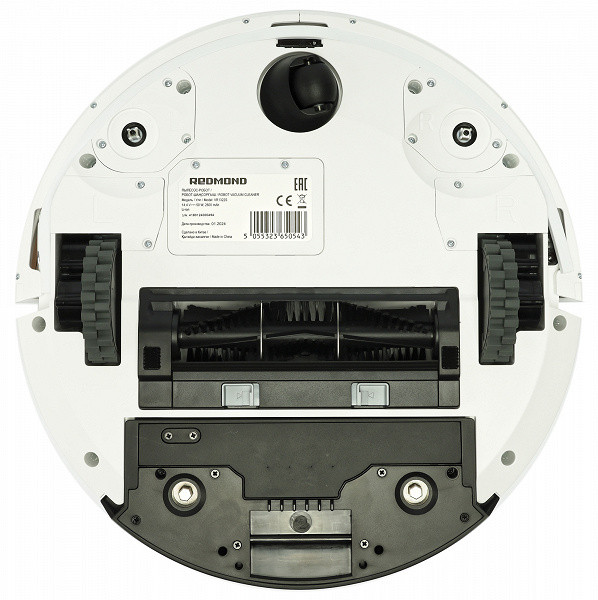
In the center is a traditional rotary brush with alternating rubber slats and sweeping brushes. The frame is movable, which ensures the best fit to the floor.
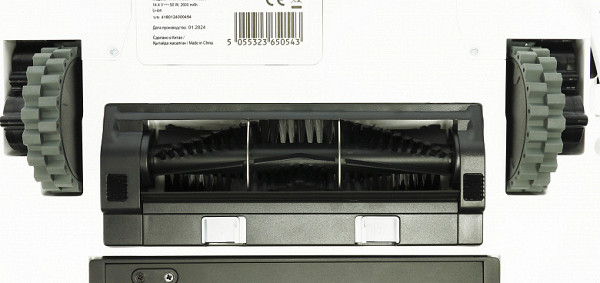
The frame is secured in place with two latches, and to protect the brush from wire winding, it has two metal jumpers.

An additional plastic latch is used to secure the brush inside the robot's body. Frankly, it doesn't look very reliable.
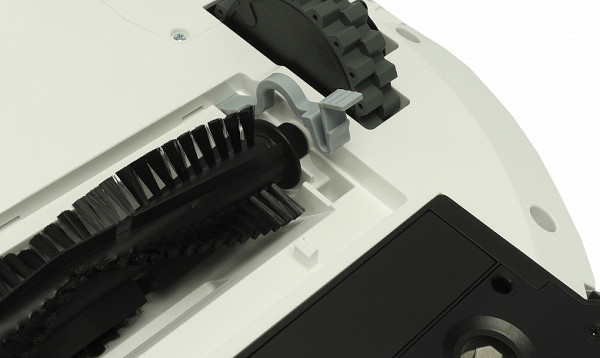
Let's look at the bottom side of the robot.
Three pairs of infrared sensors are located along the outer perimeter, preventing falls when there are differences in height, such as stairs. In front, there is a classic guide wheel enclosed in a rotating sphere.
There are places for installing brushes on the left and right. They are fixed in place without any additional devices — they just snap into place. The brushes are divided into «left» and «right».

This model does not have a carpet sensor.
The drive wheels are equipped with rubber protectors with an «off-road» pattern, providing excellent grip on various surfaces. The suspension pitch varies from 18 to 30 mm. The developer does not indicate what heights of obstacles the robot can overcome, but in our test room with thresholds up to 1.5 cm high, the device functioned successfully, although with some difficulties when moving at an angle to the threshold.
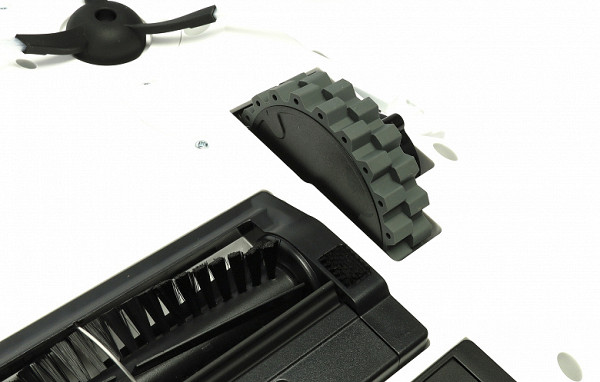
In the front part, between the brushes and the support wheel, there is a compartment for the battery. The robot uses a traditional assembly of four 18650 elements, with a total capacity of only 2600 mAh.
Now let's take a look at the self-cleaning station. It is made of black and white matte plastic.
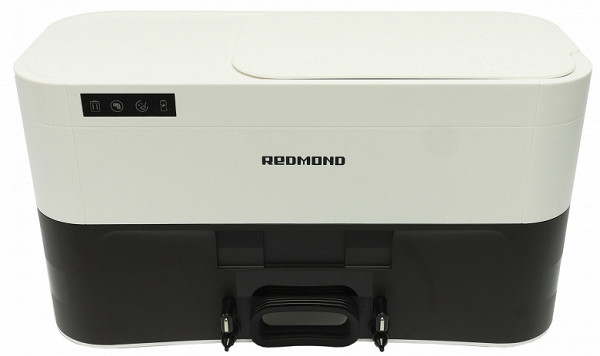
At the bottom of the station are spring-loaded contacts for charging the robot, as well as a rubber bell for dumping collected garbage. Next to them are IR sensors that help the robot when parking the robot.
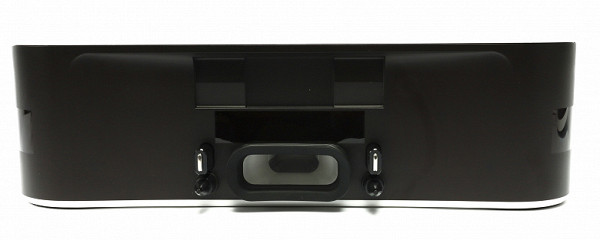
At the top of the base there are indicators:
- lack of dust bag
- clogged suction hole/suction tube
- cleaning of dust container
- charging
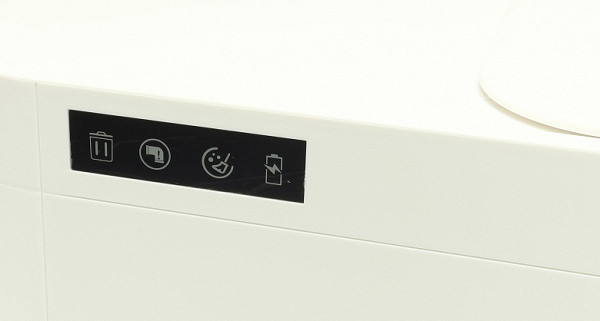
There is an air outlet grille on the side of the base. The power cord is also connected on the side.

The garbage bag is installed under the hinged top cover.
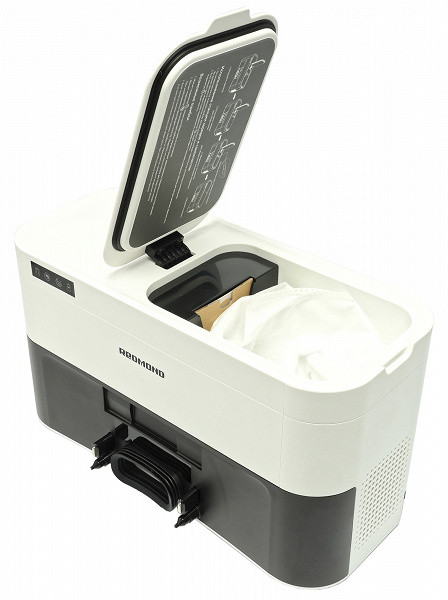
The base has special guides for installing the bag, and at the bottom of the dust collector there is a removable filter that prevents debris from getting into the built-in vacuum cleaner if the bag accidentally breaks.
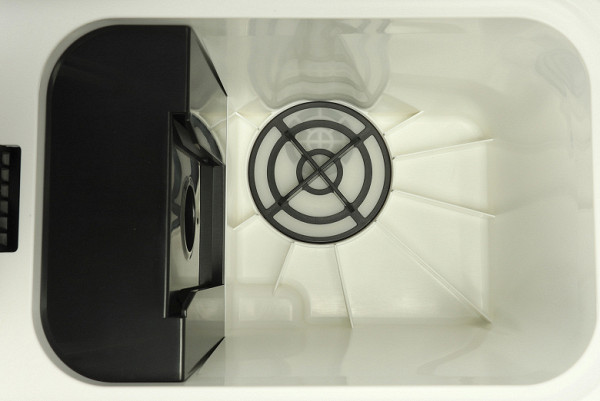
The dust bag has a capacity of 3 liters. A cardboard cover with a hole is used to fix it in place.

The bag has a traditional “curtain” that allows you to close the bag so as not to spill garbage when removing it.The bag has a traditional “curtain” that allows you to close the bag so as not to spill garbage when removing it.
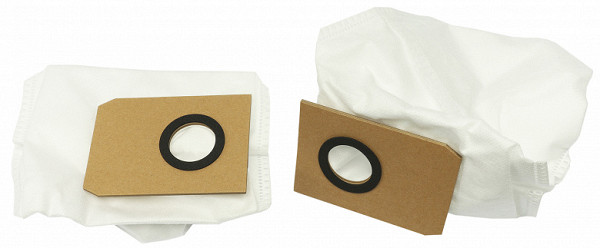
The infrared remote control does not have any special features. It allows you to issue standard commands to the robot, such as changing the suction power and water flow intensity. The remote control is powered by two AAA batteries, which are included in the kit.
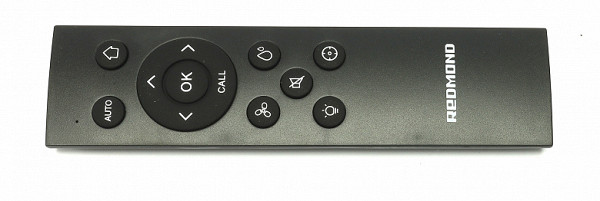
In the kit we also found a brush-knife for cleaning the robot. First of all, it is useful for cutting off wound threads and hair, as well as for removing dust from the HEPA filter.
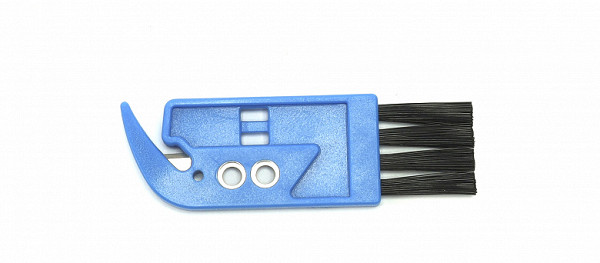
Instructions
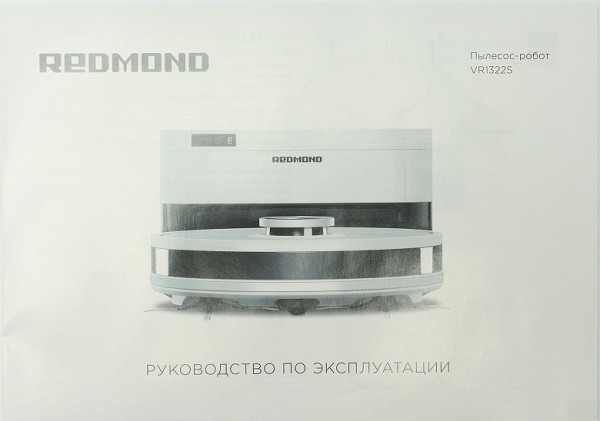
The text part of the manual is presented in two languages - Kazakh and Russian. The Russian-language part takes up nine pages and includes detailed instructions on safety, management, operation and maintenance of the device.
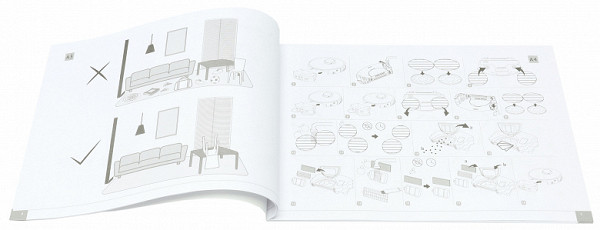
The document ends with a list of technical specifications and a table of possible malfunctions with recommendations for their elimination.
Control
The robot can be controlled using two buttons on the body, each of which has an LED backlight. The first button turns on the device and starts the automatic cleaning mode, the second sends the robot to the base for charging. The button backlight indicators show the current status of the device (constant glow or flashing), details can be found in the instructions.
For initial use, these buttons are sufficient, but it is more convenient to control using a remote control or a mobile application.
Remote control
The delivery set includes a small infrared remote control, which expands the functionality of the robot control. The buttons on the remote control are intuitive thanks to the pictogram icons:
- Automatic mode
- Return to the charging station
- Select the direction of movement (with manual control)
- Start/end cleaning
- Search for a vacuum cleaner (Call)
- Select suction power
- Select the water supply level
- Turn on/off voice messages
- Turn on/off the indicator
- Quick cleaning of a fixed area
The remote control is powered by two AAA batteries, which are not included in the kit.
Control from smartphone
For more convenient control of the robot, the manufacturer suggests using the Redmond Robot app, available for Android and iOS. Here's how it works:
First, you need to register by entering your email address or mobile phone number and providing information about the location of the device.
To add a device, you need to take a photo of the QR code (for example, from the instructions) or add it manually. Next, you will need to specify the name and password of your wireless network (Wi-Fi, 2.4 GHz). The connection mode is activated by long pressing the button on the device body. The connection process takes only a couple of minutes and is hassle-free.
Before starting operation, the application checks the relevance of the firmware built into the vacuum cleaner and, if there are updates, will offer to update it.
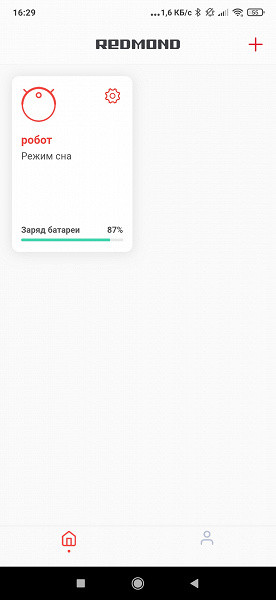
The main screen displays a map of the room (empty at first, it fills in after the cleaning starts). The top of the screen shows the time of the current or last cleaning, the area treated and the battery level.
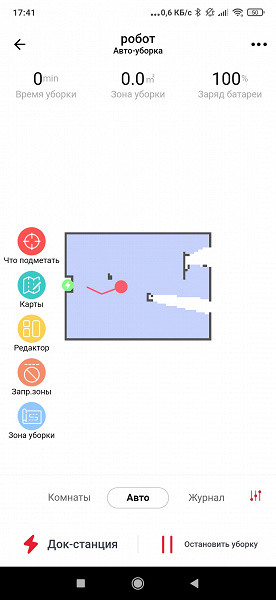
At the bottom of the screen are the control buttons: «Room» (cleaning in selected rooms), «Auto» (automatic cleaning) and «Log» (cleaning history). During the robot's operation, «Docking station» (return to base) and «Stop cleaning» are displayed instead of these buttons.
The icon with switches allows you to adjust the suction level, the degree of mop wetting, the mode of intensive cleaning on carpets and the mode of washing the floor in a Y-shaped pattern.

On the left side of the main screen there are map editing buttons, as well as buttons for selecting cleaning zones. The application contains tips explaining how to correctly perform a particular operation with the map.
The top of the screen displays statistics for the last cleaning, including the area cleaned and the operating time, as well as the robot's charge level.
The robot offers four suction power modes and three water supply levels.
Additional settings can be found under the "..." button.
The app includes a Do Not Disturb mode, scheduled cleaning, manual control of the robot, and a function to resume cleaning when the battery is low. There aren’t too many options.
However, the map editing mode does have some useful features. You can customize the settings for each room, including the suction level, the degree of humidification, and the number of cleanings. This is especially useful for deep cleaning areas like the kitchen or pet-friendly areas.
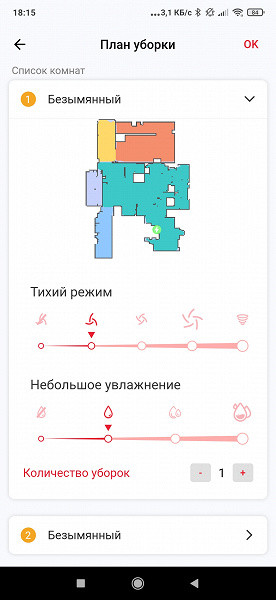
The app doesn't have any special settings for the base, so the robot will return to the base and dump the garbage after each cleaning cycle.
On the settings page, you can rename the device (the app supports several robots at the same time, which helps avoid confusion), share access with other accounts, and check for firmware updates.
Operation
When removing the vacuum cleaner from the box, remove the packaging and shipping materials, including the protective pads on the bumper. Install the side brushes and fully charge the device. The first charge may take longer, so it is better to leave the vacuum cleaner on charge overnight.
It is recommended to place the charging station near the wall, providing a free space for the device to move within a radius of two meters. Before starting cleaning, remove wires, bags, shoes, toys and other objects from the floor that the robot can damage or knock over. Also check that fragile objects or burning candles are removed from the floor and furniture that the robot can touch.
Although the vacuum cleaner can be used without a smartphone, controlled using the buttons on the body or the remote control, full capabilities are opened after installing the mobile application. It is best to configure the application before starting to use.
The robot remembers and edits maps, allowing you to combine and separate rooms, set virtual walls and no-go zones. You can set the water supply level and enable the «wet cleaning only» mode for each room. Support for multiple maps will be useful for owners of two-story houses.
The map is created and displayed on the smartphone screen during the first cleaning. The robot accurately detects boundaries and obstacles thanks to the lidar sensor, which ensures the creation of a detailed map. The robot may not detect only low obstacles.
And here it is, automatically divided into rooms.
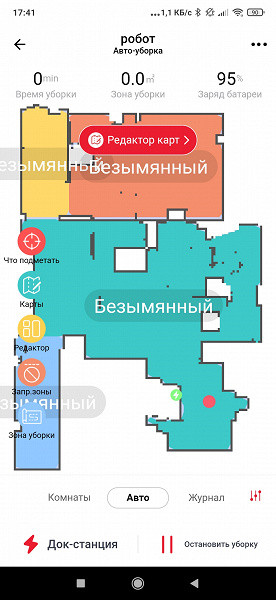
During the cleaning process, the robot goes through the room room by room. First along the perimeter, then in a serpentine pattern.
We observed the same thing at our test site.
The robot's wet cleaning quality can be rated as excellent. The device effectively supplies water to the fabric, gently wipes the floor and leaves almost no extra drops or excess water.
What disappointed us a little? This model does not have a sensor for detecting the type of surface, so the robot cannot automatically recognize carpets. In addition, the attachments for attaching the mop begin to rust quite quickly. This is especially surprising, since this is the only part of the robot that is constantly in contact with water. What's the point?
Care
The plastic parts of the device can be cleaned with a damp, well-wrung-out cloth. Garbage bags should be replaced as needed, and the built-in dust container, in principle, does not require regular cleaning, although it is worth checking it periodically for foreign objects.
The HEPA filter should be cleaned with the included brush, but it cannot be washed.
The brushes and mops for wet cleaning can be washed under running water, while the use of a light detergent is acceptable. They should be dried naturally.
The remaining elements of the device should be wiped with a damp cloth, and the sensors and contacts — with a dry soft cloth.
All care information is presented in the form of illustrations in the instructions, which allows you to familiarize yourself with it in a matter of minutes.
Conclusions
The Redmond VR1322S robot vacuum cleaner demonstrated typical quality for devices of this class. Its cleaning capabilities, obstacle recognition and overall functionality meet expectations. The robot itself works quite quietly, but the base for dumping garbage makes a noticeable noise, which is quite expected.
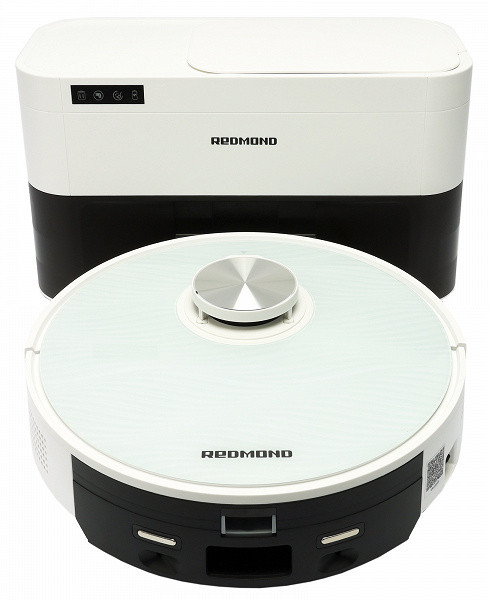
The positive aspects of the device include its elegant design and good quality of both dry and wet cleaning. However, the model has some drawbacks: limited battery capacity and no surface sensor. The robot cannot recognize carpets, which makes it impossible to use the enhanced suction mode on carpets.
The dust container and water tank are small, so the device is best suited for small rooms and regular cleaning. In large apartments, where dirt appears quickly, it will have to be started more often or more attention will have to be paid (emptying the dust container manually and adding water twice per cleaning).
The battery has a capacity of only 2600 mAh, which is two times less than the standard 5200 mAh of robots with similar functionality.
An interesting solution with a motor for wet cleaning, built into a combined container, does not affect the quality of floor washing.
Pros:
- dry and wet cleaning
- accurate map creation
- good level of interaction with the application
Cons:
- relatively low battery capacity
- no carpet sensor
- appearance of rust on wet cleaning attachments

